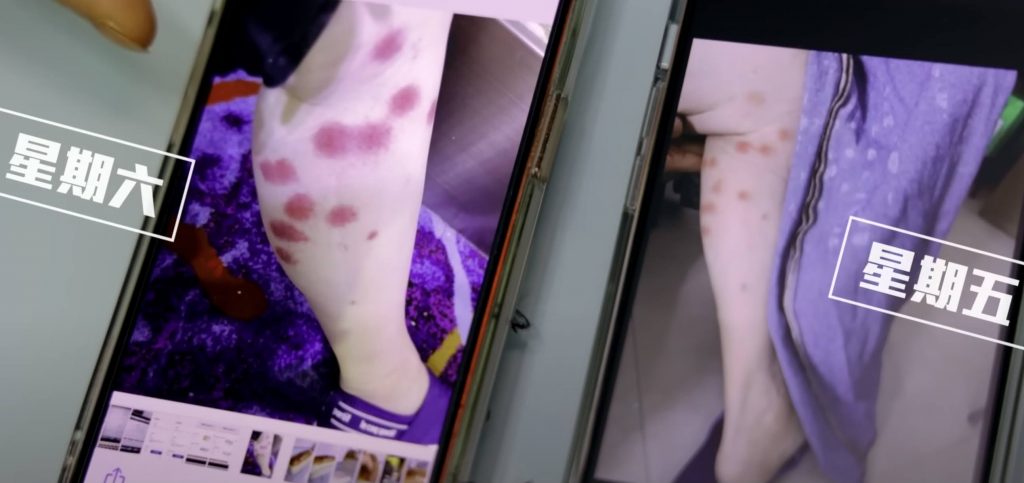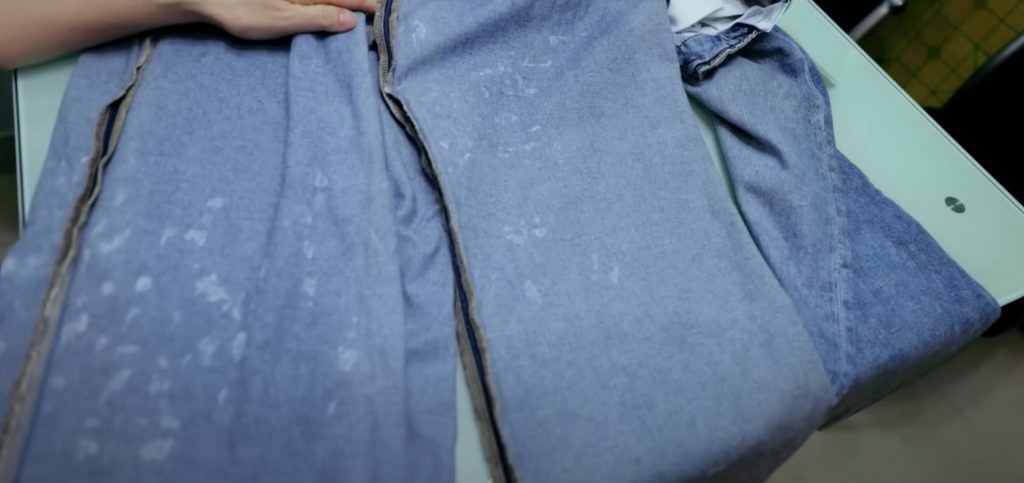Published on July 12, Channel C HK investigated and interviewed a terrifying case of a severe skin reaction of itchiness and scarring from none other than denim jeans. In the 10 minutes documentary, Channel C HK covered the story and reached out to a specialist to find out how a pair of denim could cause such a disaster.
The buyer, Mrs. Chen, reported that on April 14, she bought a pair of jeans from H&M in Kwun Tong that was left in the shopping bag at home. A week later, she wore it to eat out with her family. After some hours, she felt some itchiness, so once she returned home, she washed the jeans.
A few days passed, and she started noticing dollar coin-sized red scars on her legs. She suspected that dust mites were the culprit and vacuumed her home, but on the back of her head, she was confused about how dust mites could cause such severe itchiness and scarring.
Mrs. Chen described the disc-shaped scars to be stiff and bruised. She would hit her legs with her palms instead of scratching them to temporarily relieve the itchiness, but as it never stopped, she had hit herself so much that her legs started to sore. She would use ice packs as an alternative to calm down the itchiness, but they were only effective for some time. The unending itchiness has also caused sleepless nights that were driving her insane. Worse, she took pictures of her legs daily to record her skin reactions, as each day went by, her scars would get darker and bigger where they had grown to be as big as a 5 dollar coin.

Mrs. Chen never suspected the H&M jeans to be the causer until she took them out of the washing machine to find some white spottings on the inside of her jeans, in areas where her scars appeared on her legs. When she went to the dermatologist for some medicine, they were shocked at how bad her skin was reacting and had to prescribe multiple drugs, which helped the size of the scarring decrease to 1 dollar and 50 cents. The dermatologist guessed that it had to do with potential chemicals or insects.
Mrs. Chen does not have a history of allergies or a skin reaction similar to this case. She also wondered if it had to do with the laundry detergent she used, but it was unlikely as her husband had no such reactions and the family has used it as a household commodity for a long time.
The reporter took it upon themselves to dig deeper. On the day of the interview, the reporter went to the same H&M store and bought the exact pair of jeans to compare them to the one Mrs. Chen owns. Then, to their horror, the newly purchased jeans also appeared to have white spots on the inner fabric! The jeans were then sent to a laboratory for a chemical and bacteria detection test.

Surprisingly, the test result detected no toxins from the jeans. As seen in the report, none of the aromatic amines (derivatives from azo dyes) were detected. According to Benkhaya et al. (2020), “Azo dyes are the most important synthetic colorants which have been widely used in textile, printing, paper manufacturing, etc.” Currently, azo dyes are heavily restricted in multiple countries. Though it does not answer the mystery, this is good news because Dr. K Kwong, Ph.D. of Chemistry, mentions that when azo dyes are absorbed into the body, they can cause cancer.

So what is causing these white spots? Dr. K Kwong explains that it is likely a manufacturing dye job or the ‘hydrolysis’ process to create trendy effects on denim jeans, which includes sprinkling corrosive alkalis. The hydrolysis of cotton denim enhances the visual effect of color fading (Patra et al., 2018). The white spots are a product of the chemical reaction between alkali and denim, sodium bicarbonate. In the 1Source database, sodium bicarbonate a.k.a baking soda, may not be hazardous but has the potential harm of irritating the skin. Especially when encountered with moisture (like sweat), it forms heat and carbonic acid, making it a more potent irritant on the skin.
Wash Your Clothes!
Dr. K Kwong wraps up by reminding us of the importance of washing our new clothes from the mall/boutique, especially if the garment is dark, as there would be more chemicals in them. Sodium bicarbonate is water-soluble, so washing your new jeans would decrease the risk of irritation and inflammation.
Seconded by dermatologist and venereal specialist Dr. Feng Wei Jie, he explains the importance of washing new clothes to avoid allergic reactions to dust mites and pigments. When we wear unwashed clothes, our sweat makes our skin more easily penetrable by these mites and irritating color pigments from the fabric.
Personal Notes and The Bigger Picture
Generally, it is hygienic to wash your new clothes. Growing up, my mum would always tell me to wash my new clothes before I wear them, and as a kid, I would do it without question, so now it has become an unconscious habit. Watching this documentary gave me a new reason to give them a wash. And maybe 2 washes to all my black graphic tees.
If dyes could cause irritation and inflammation on the skin, what other harm could they cause? Environmental. Although we learned that we could avoid toxins from our clothing by washing them, it doesn’t mean our clothes are not toxic to the environment as well. As covered before on 1Source, there are multiple causes of how fashion destroys the environment. Another memory this documentary made me think about was my visit to a silk convention in Muang Thong Thani, Thailand. There was a natural dye workshop where people could manually screen print over a stencil on a handkerchief with one of their plant/botanical derivative dyes.
These natural dyes are important because they are the alternative to synthetic pigments that have caused water pollution and bodily harm. According to Rare & Fair, Since natural dyes are biodegradable, non-toxic, and non-allergenic, they are a safer option for the environment and ourselves, as they are less likely to cause cancer. On the other hand, natural dyes may not be reliable for mass producers as the product output will not be consistent and costly. Even though they are less harmful, natural dyes still come with some environmental and health risks.
So I hope this informative report from Channel C HK not only get people in the habit of washing their new clothes but spark changes in the fashion industry and consumer trend to use better options. Like promoting eco-friendly fashion brands or for big MNCs like H&M to incorporate these options, they already have a Conscious Choice Collection, I see no reason why natural dyes should not be introduced to the general market.
Honorable Mentions: Eco-friendly fashion brands in Hong Kong

References
Benkhaya, S., M’rabet, S., & El Harfi, A. (2020). Classifications, properties, recent synthesis and applications of azo dyes. Heliyon, 6(1), e03271. https://doi.org/10.1016/j.heliyon.2020.e03271
Channel C HK. (2022, July 12). 恐怖!靚太買H&M牛仔褲 著完疑似出滿疹痕到癲一撻撻!H&M派人收走條褲做化驗|Channel C HK [Video]. YouTube. https://www.youtube.com/watch?v=zAP-PhoB_4Y
Leather Research Laboratory. (n.d.). AZO DYES. leatherusa.
Patra, A. K., Madhu, A., & Bala, N. (2018). Enzyme washing of indigo and sulphur dyed denim. Fashion and Textiles, 5(1), 1-15.
The social and ecological impact of naturally dyed clothing. (2021, July 25). RARE & FAIR. https://rareandfair.com/blogs/the-slow-scoop/the-social-and-ecological-impact-of-naturally-dyed-clothing
Sodium bicarbonate. (n.d.). 1Source. https://1source.com/ingredients/sodium-bicarbonate

